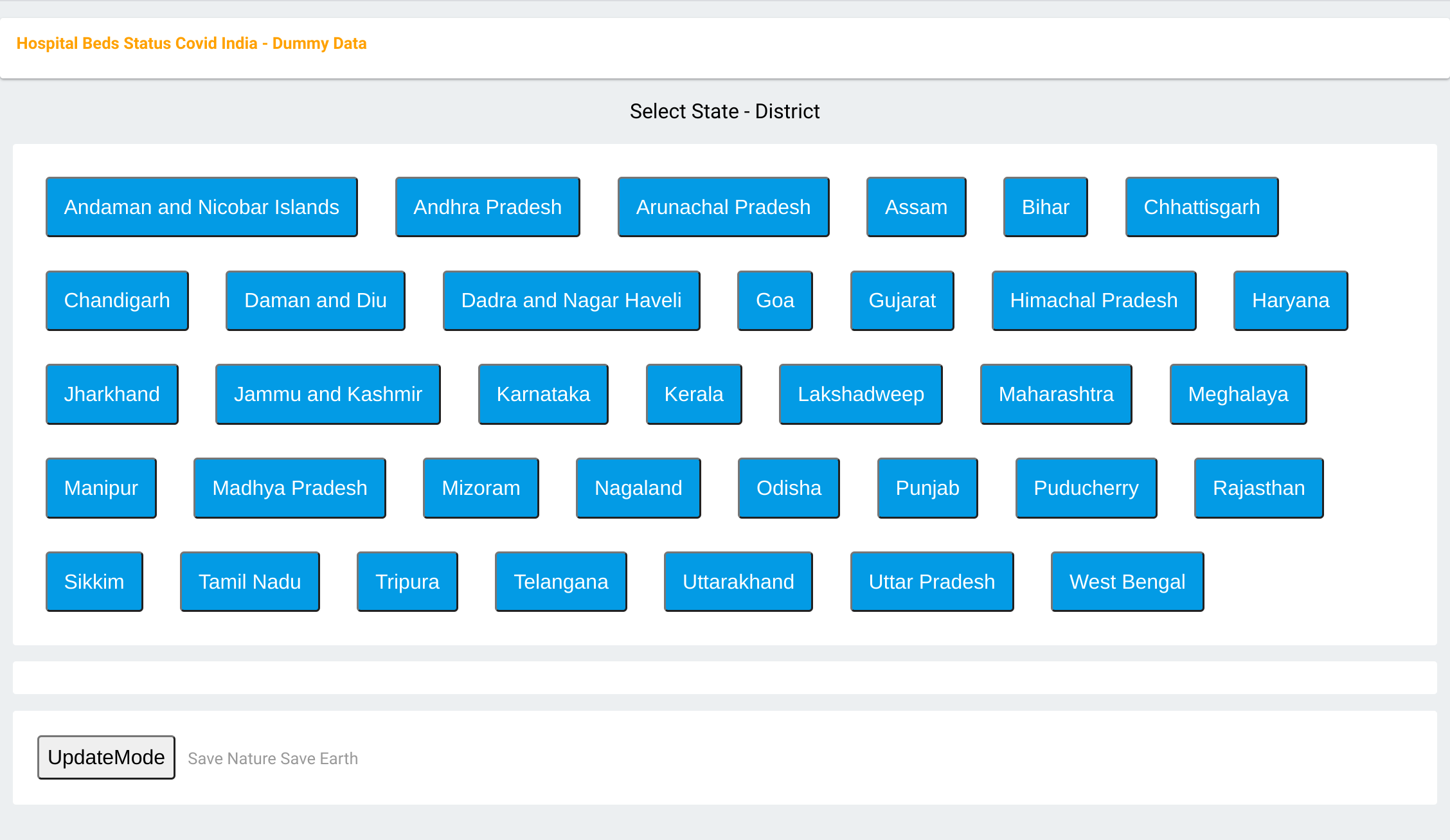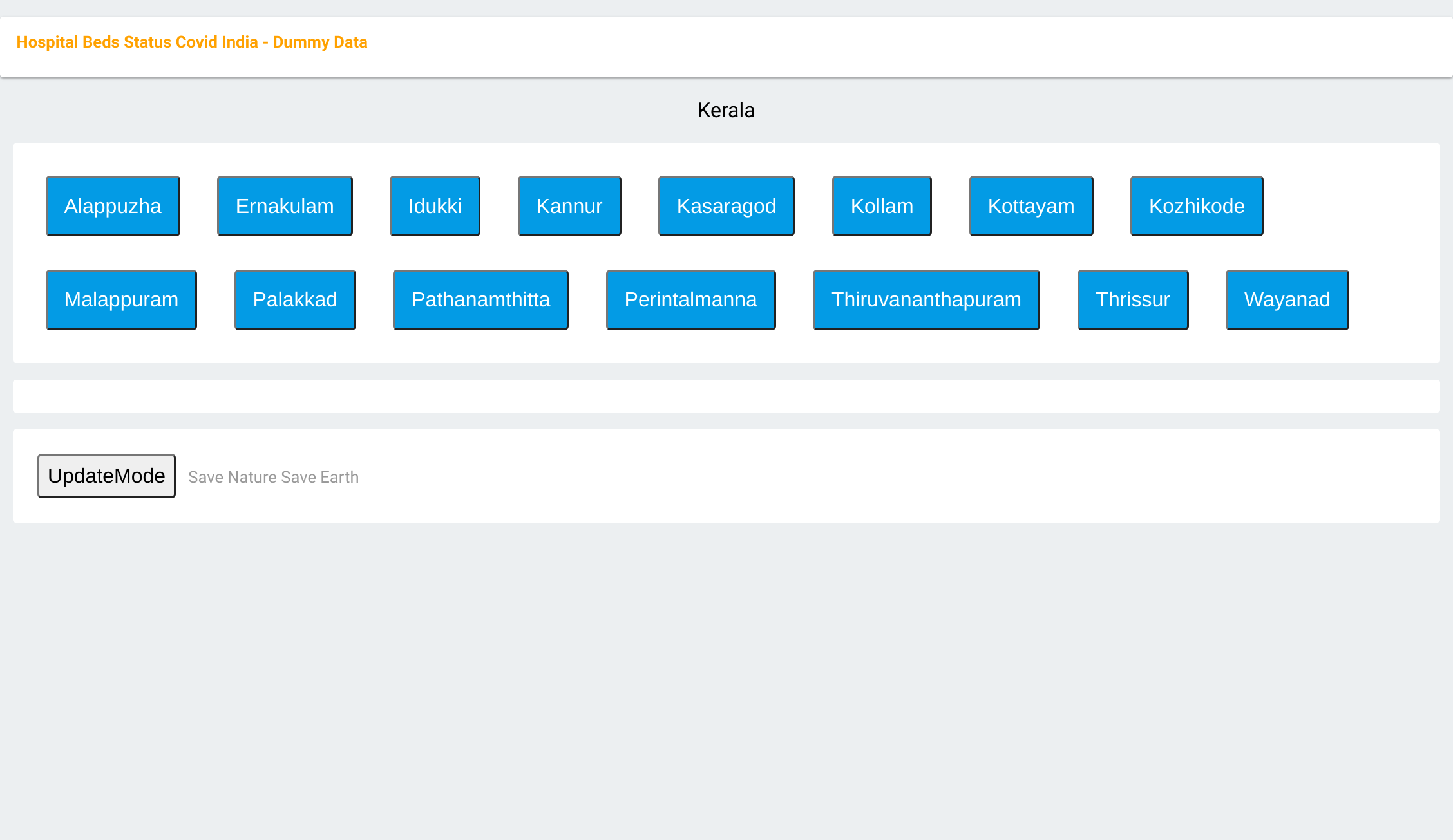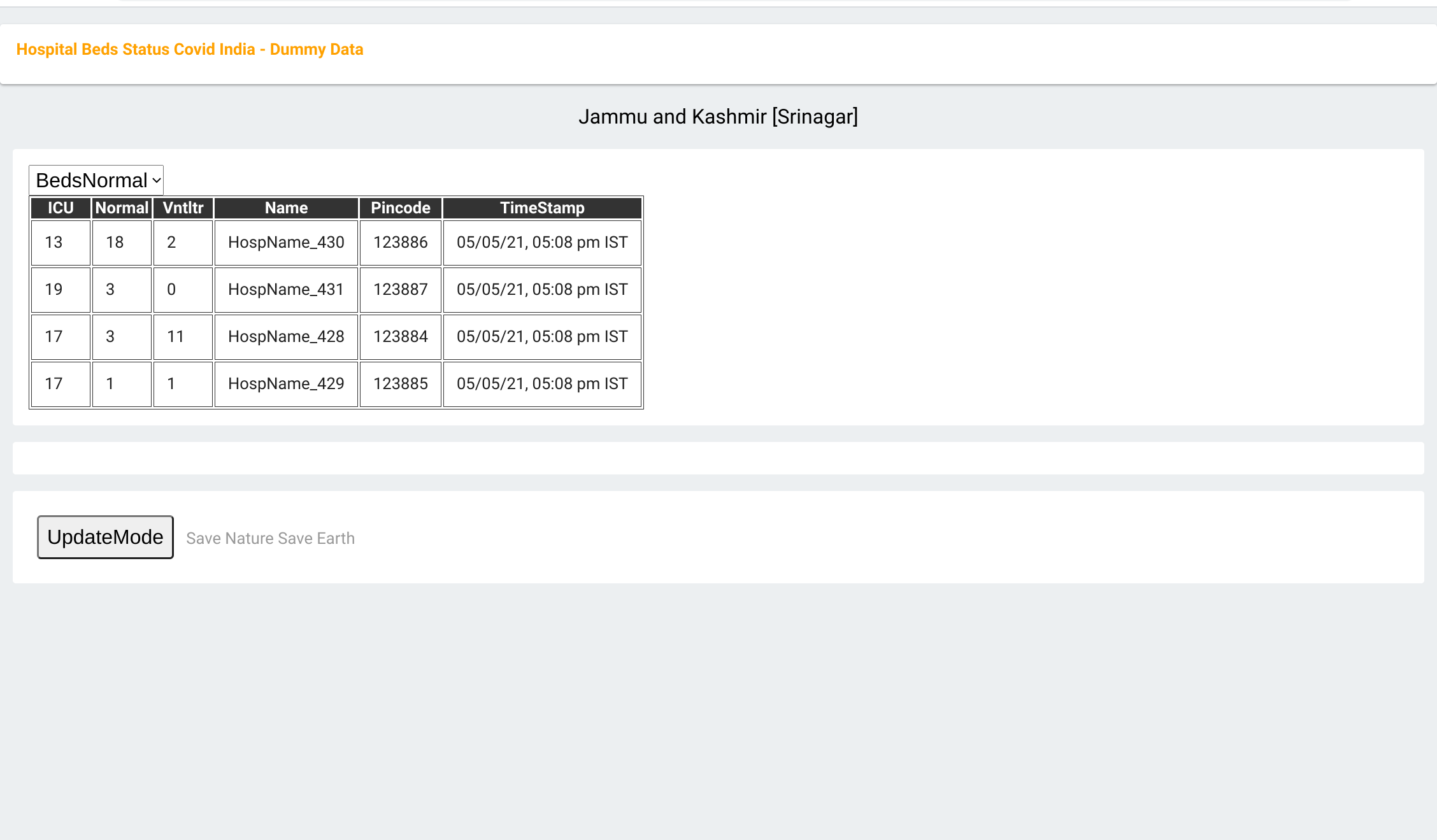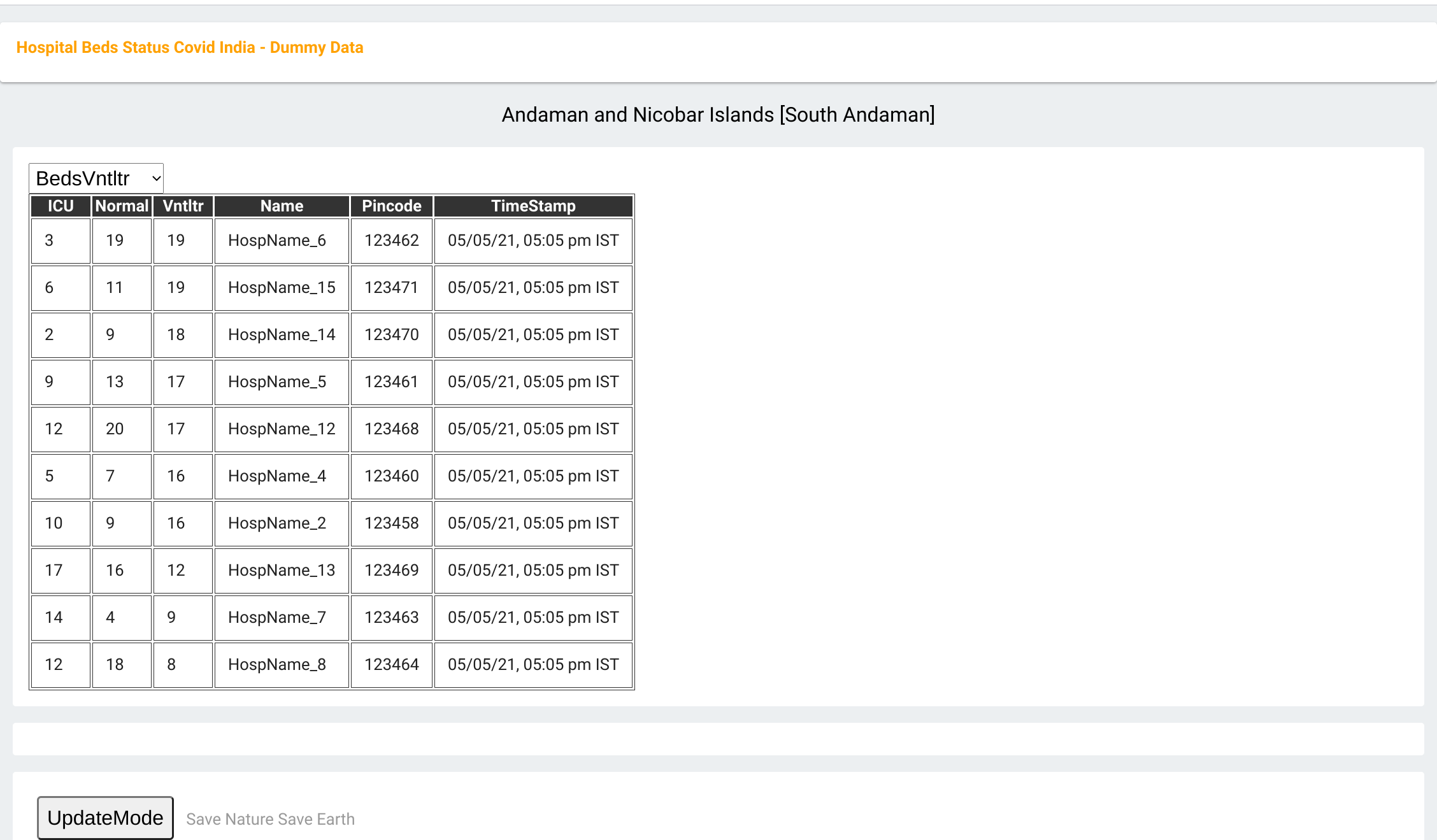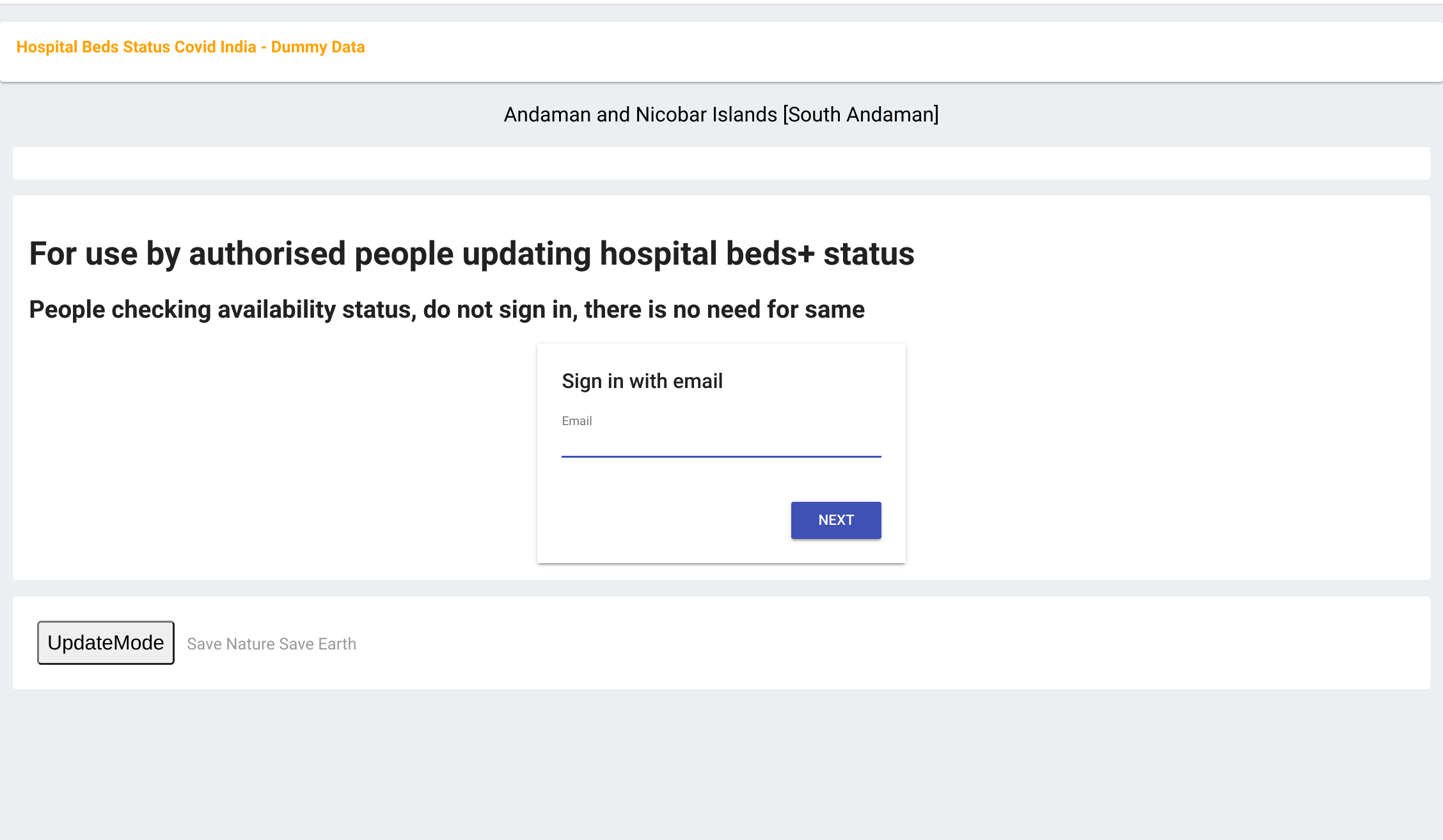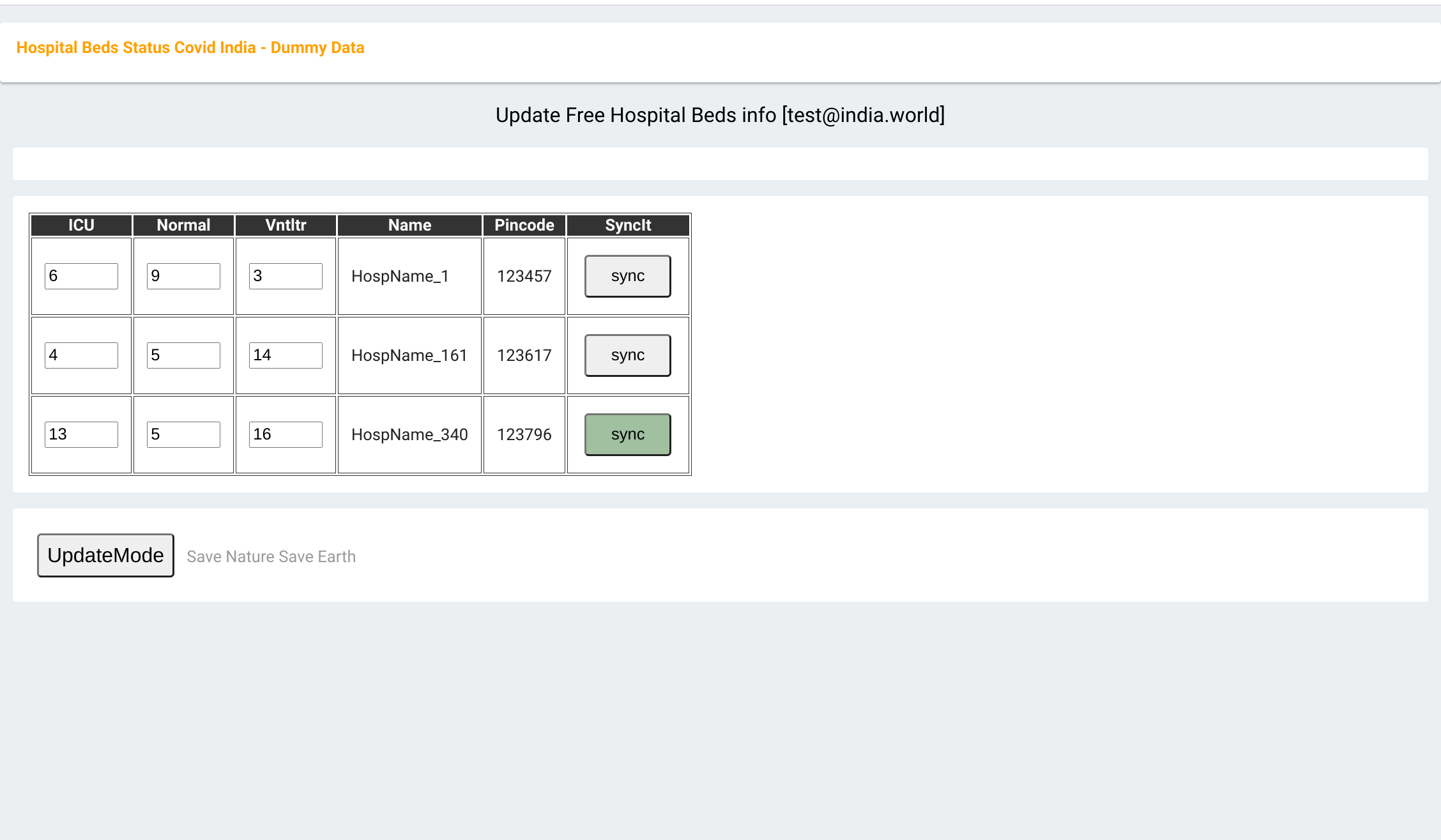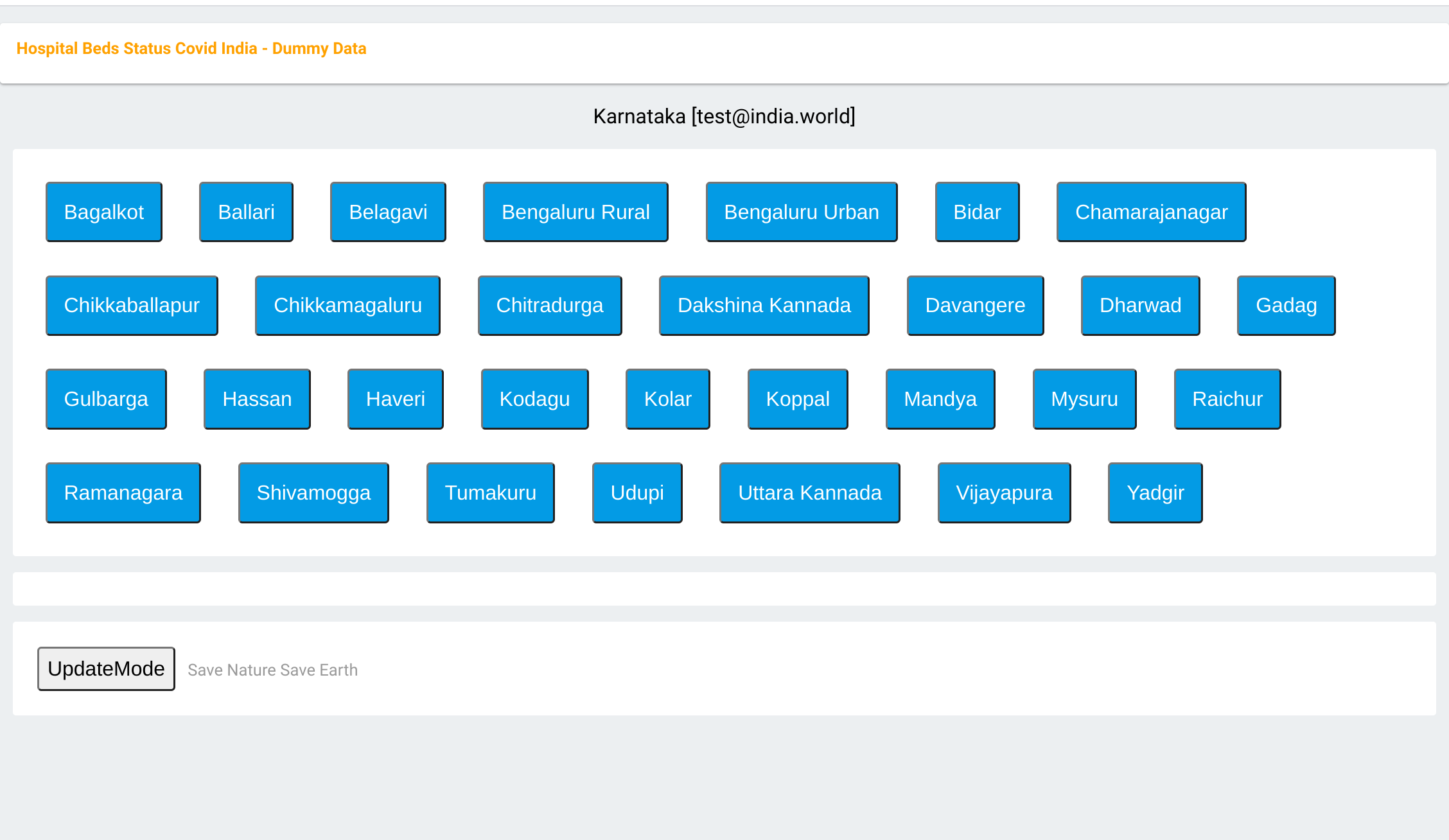Author: HanishKVC Version: 20210502IST1822
This is a keep it simple online hospital beds+ status system, where the hospitals are grouped into states and inturn districts. One can look at the status of availability of the tracked type of resources wrt the hospitals.
Users: Can check the status of bed availability wrt the state and district they are interested in.
HospitalAdmin/DataOwner: Can update the availability status of beds for the hospitals, they are responsible for.
Status: TODO
Again follows a simple minded kiss approach, which doesnt get in the way of how things are managed on the ground based on practical needs/issues that may come day in and day out in a medical setup.
It uses the bed availability status updated by the hospital admins/data owners, to inturn allocate people needing beds to the nearest available one and inturn update the bed availability status.
This extends/builds on the bed availability status logic.
PatientAdmins(district lvl): They can add patients needing beds into the system, along with the identification of the nearest hospital wrt the given patient.
AllocationAdmins(district lvl): The person responsible for allocating the beds at the district level, triggers the allocation logic.
NOTE: The hospitals along with district administration may decide to keep some percentage of beds outside this allocation system, so that they can cater to emergency needs as and when they may develop at their end. If a situation warrants additional beds to be used, beyond what they had originally anticipated, they can always reduce the number of beds provided through this shared system.
Users select the state followed by the district for which they want to know the status. Inturn the system will show upto N number of hospitals with highest availability wrt one of the predefined set of parameters like normal/icu/ventilator beds, ... in that district. The user can choose based on which parameter they want to see the list of hospitals. Thus people can query the availability status wrt the predefined set of parameters, and inturn the hospitals in the selected state-district which have availability based on selected parameter will be shown.
THe timestamp wrt when the data for any given hospital was last updated is also shown, so that users can have a rough idea of how current the data may be wrt each hospital.
Any person can access the availability status maintained by the system, without needing to login to the system.
NOTE: Microsoft IE is currently not supported, On windows one will have to use the newer Microsoft Edge or Chrome or Firefox or ...
The system allows data owners to be assigned wrt the hospitals in the system.
The data owner is responsible for updating the availability status wrt the hospitals for which they are assigned as the admins, at periodic intervals.
Initially the admin/data owner needs to create a sign in account in the system. Inturn the central team managing the system need to cross verify the credentials of the admin/data owner and inturn assign them as the admins for the needed set of hospitals.
Each hospital can have a single administrator.
Each administrator could be data owner for more than 1 hospital.
When a new user sign's into the system, a verification email is sent to the specified email, to validate the same. The user needs to complete the verification. In future the store rules will be updated to cross check that the admin user has a verified email.
The data owner needs to login to the system and inturn periodically update the availability status wrt the parameters being tracked in the system. As the data owner updates the data, the system will automatically update the time stamp wrt the corresponding hospital.
Once a admin logs into the system, it will show all the hospitals to which they are the admin. Inturn it gives the option to update the availability status wrt all the hospitals from a single view.
Once the admin has updated availability data wrt any of the hospital. They need to click on the corresponding sync button to trigger the same to be updated to the system's backend.
The sync button associated with each hospital is color coded to indicate, the status of the last update/sync operation triggered wrt that hospital. So they can know, if they need to trigger the sync again or not.
Gray/DefaultColor: Sync has not yet been triggered for the hospital.
Blue: A sync has been triggered, and is in process.
Red: The sync operation has failed. (User can press sync button to try again).
Green: The sync operation has succeeded.
NOTE: Moving away from the page will clear the color coding.
NOTE: If one has modified data wrongly and has not yet synced it to the server, one can press the UpdateMode button and the logic will refresh the data in the shown table to what is stored in the system. Inturn the data owner can change/update to the needed value and press sync button to sync it to the backend server.
Reloading the page will reset the app to main screen and the user will have to login again, if they are data owners/hospital admins.
This is a online system built on top of a cloud based NoSql database as the backend, and html+javascript as the front end. Thus is inturn implemented as a serverless system, thus not requiring any micro managing of server. The backed system selected allows the system to scale up or down as the load on the system increases or reduces.
Google Firebase firestore is used as the NoSQL backend. It allows access control rules to be defined wrt the different set of records maintained in it. This inturn allows the system to be built without requiring any additional backend logic in this particular situation.
If possible (logistically speaking, wrt getting the required data from the hospitals) as one may want to add additional parameters wrt the hospital to be maintained and inturn shown to the end users of the system, the NoSQL allows the schema to evolve as and when required.
Few such additional parameters could be
Oxygen availability (may be normalised per Bed).
...
It is relatively easy to add such additional fields to the system.
Additionally firebase auth is used to simplify the authorisation system while also keeping it secure. Also firebase hosting is used to distribute the small set of html+js files.
Admin scripts are used to
initialise the database wrt the states/uts and their districts/regions, as well as the hospitals in the system.
assign administrators to hospitals.
Firebase-Admin sdk is used to build these admin scripts.
The state/uts/districts/regions info even thou available in the database, is not directly picked from it, but instead picked from a json file maintained on the hosting server. Thus avoiding unnecessary eating into the data base queries quota, but instead chipping into the hosting quota, which should be fine, as nothing else is hosted other than the html+js files.
If for some reason the logic is not able to retrieve data within a predefined time, then under some circumstances we show a message at the bottom to alert the user to the same and asking them to check internet connection and or ... This needs to be updated to also trap internally acknowledged failures at db bridge level and show same or more appropriate message. FOR NOW if user doesnt see any data, then they will mostly try reloading the page and that should take care of things at one level.
If anyone finds this logic/system useful, feel free to duplicate it and customise it for your specific use case. This is released under GPL.
When doing the same, as part of the same, at a minimum you will need to
replace the project id in .firebaserc with the one you created for yourself.
download the service account token for your project and store in a safe place and update the environment variable in setup-env.sh appropriately. This is need for using the firebase-admin sdk and inturn the admin scripts which I have done.
The system is administered using a set of admin commands to a admin script.
On a admin system (which could even be a local (non cloud) machine) the service account token for the system is maintained. Inturn the admin script in the Firebase.Admin/HBCINAdmin folder is run to manage the system. Ensure that the service account token is stored securely and not uploaded to source control system or so.
Update the path in setup-env.sh shell script and run source setup-env.sh to make the same available to the admin script.
To create a test dataset containing the states/uts and districts/regions of india along with a randomly generated set of hospitals data, run
node index.js create_testdata
To create a test admin user using which one can look at updating hospital bed availabiity status, one needs to do the following.
Create a user called test@india.world in the SignIn UI of the WebApp.
Next run the following to set the email verified flag for this dummy email id
node index.js enable_testadminThen use import_hospadmins to enable test@india.world as the data owner for few of the hospitals in the system. Its assumed that you have created a sample admins file called sample.admins.json within the subfolder called config, wrt pwd/cur directory.
node index.js import_hospadmins ./config/sample.admins.json
To create a actual dataset for deployment, one could use the default regions data, which is already there for India, or create a new statesuts_districts.json file. Inturn create the json file containing hospitals data and the json file containing the hospital admins data and then run
node index.js create_regions
node index.js import_hospitals ./config/hospitals.vDate.json
node index.js import_hospadmins ./config/hospital.admins.vDate.json
NOTE: In the above example, it is assumed that the hospitals and their admin details is stored in a folder called config, with in the folder containing admin script.
NOTE: The hospitals and their data owners/admins data is maintained as simple textual json files, so that it is simple to manage it and track it when updating and or later using simple text related tools.
NOTE: It is not necessary to run all these commands at the same time, it can be run at seperate times. If one is changing the admin and or adding new hospitals to the system. New hospitals.json can be created which contains only details for the new hospitals and hospital.admins.json can be created with admin details for new hospitals as well as hospitals for which the admin is being changed. Inturn run the same import_hospitals/import_hospadmins command as before but with the new json files being passed to them.
node index.js import_hospitals ./config/new.hospitals.vDate.json
node index.js import_hospadmins ./config/updates.hospital.admins.vDate.json
NOTE: As the hospitals data and the admins data will change very rarely, it is managed in a simple raw way, for now.
The GenHospDataTool/generate_statesuts_hosps.py helper script can allow one to create the states/uts/districts/regions json file, as well as the hospitals json file. These inturn can be imported into the system using create_regions and import_hospitals command to the admin script.
This script uses the hospitals directory data file from data.gov.in to generate the json files. One needs to manually download the hospitals directory data file into a folder and inturn run the generate script from that folder.
Even thou currently all the hospitals in the data set from data.gov.in is blindly translated into the hospitals json file, without any filtering. From someone looking at a actual deployment perspective it doesnt matter because. In a deployed system, where hospitals json file is imported without the TEST mode, all these hospitals will be hidden by default (bcas beds availability value will be -1). ONly when a data owner is assigned to a hospital and inturn the data owner sets a value greater than 0 wrt beds availability for a given hospital, that hospital will appear in the list of hospitals from the end user's perspective.
This helper script generates hospitals json file to match the data schema of the hospitals collection and its hospital documents, as used by this system.
{
"HOSPID1": {
'Name': "Hospital Name1",
'PinCode': PINCODE,
'StateId': STATE_ID,
'DistrictId': DISTRICT_ID,
'BedsICU': ICUBEDS_FREE,
'BedsNormal': NORMALBEDS_FREE,
'BedsVntltr': VENTILATORS_FREE
},
"HOSPID2": {
'Name': "Hospital Name2",
'PinCode': PINCODE,
'StateId': STATE_ID,
'DistrictId': DISTRICT_ID,
'BedsICU': ICUBEDS_FREE,
'BedsNormal': NORMALBEDS_FREE,
'BedsVntltr': VENTILATORS_FREE
},
...,
"HOSPIDN": {
'Name': "Hospital NameN",
'PinCode': PINCODE,
'StateId': STATE_ID,
'DistrictId': DISTRICT_ID,
'BedsICU': ICUBEDS_FREE,
'BedsNormal': NORMALBEDS_FREE,
'BedsVntltr': VENTILATORS_FREE
}
}
node index.js import_hospitals path/to/hospitals.json [--mode=<Normal|TEST>] [--start=<Number>]
This is the command to import hospitals json file (following the above mentioned schema) into the system. It sets the timestamp field automatically in a suitable way. By default this means using the server timestamp currently.
It supports two optional arguments
| --mode=Normal | Allow the command to run in normal mode, in which case the hospitals data is duplicated as it exists in the json file. |
| --mode=TEST | Run the command in TEST mode, in which case the beds availability data is randomly generated, ignoring any value already specified in the json file. This is useful for testing without having to specify different values for different hospitals wrt different bed types. |
| --start=N | Skip N hospital records from the begining of the hospitals json file and import the remaining hospitals. |
However if one is using the import_collection command, then even the timestamp field needs to be part of the json file.
Data owners need to setup accounts in auth system, by using the web based signin ui provided by the web based app of this system. Next they need to get their email verified with the auth system by clicking on the verification link sent to their email ids. Once the email associated with the accounts are verified, then one can assign them as data owners to specific hospitals in the system.
One can import hospital admins by using either the import_hospadmins helper command or by using the generic import_collection command.
It is recommended to use the import_hospadmins command in general.
NOTE that in either case the json file requires to be a valid json file, with no ',' wrt end of last record or any other issues.
The corresponding command is
node index.js import_hospadmins ./config/hospital.admins.vDate.json
If using the import_hospadmins command, then the json file passed needs to follow a simple json structure of
{
"HOSPID1": adminEmailId,
"HOSPID2": adminEmailId,
...,
"HOSPIDN": adminEmailId
}
Here one needs to use the admin's emailId and the logic will inturn cross check to verify if the specified adminEmilId is registered with the system or not. If not registered, then the corresponding hospital's admin id if any wont be changed.
On the other hand, if the email id is found in the system's auth database, then it is checked as to whether the hospital admin (data owner) has got their email verified with the auth system or not. If email is already verified, then the related hospital's admin record is updated to reflect that user as the admin, else a dummy invalid auth id is written into corresponding hospital's admin record, so that no one else can edit that hospital's record. And the hospital admins' need to get their email ids verified with the system at the earliest, so that they get access to udpate the resource availability data wrt the hospitals. Once they have got their email verified, the system admin needs to run the import_hospadmins for these hospital admins.
In all of these 3 cases, a message is also logged to the console.
The command is
node index.js import_collection HospitalsExtra ./config/hospital.admins.vDate.json
If the import_collection command is used, then the json file requires to reflect the HospitalsExtra collection's data schema. i.e
{
"HOSPID1": {
'AdminId': adminUid
},
"HOSPID2": {
'AdminId': adminUid
},
...,
"HOSPIDN": {
'AdminId': adminUid
}
}
In this case, the admin's uid needs to be specified in the json file. The import_collection logic doesnt try to validate anything, it will blindly update the corresponding document in the systems' backend database.
This is a generic command available for importing a simple collection of documents (firestore speak), into the backend firestore database.
It doesnt try to validate anything, but instead just does a blind transfer into the server.
Even thou import_hospitals is the recommended way to import hospital details into the system, one could still use import_collection to import the data and avoid the additional cost if any associated with server.TimeStamping (vaguely remembering reading somewhere on google site that there is a additional cost associated with server timestamping, which seemed bit odd, and I am not able to get that online page again now). However in this case you will be filling the time stamp yourself with what ever value you choose.
One can explore the regions and hospitals jsons using the following explore_jsons commands.
TO get a list of all the states run
node index.js explore_jsons path/to/regions.json path/to/hospitals.json statesls
TO get a list of all districts in a given state run
node index.js explore_jsons path/to/regions.json path/to/hospitals.json districtsls stateNameOrId
To get a list of all hospitals in a given state-district along with their details run
node index.js explore_jsons path/to/regions.json path/to/hospitals.json hospsls stateNameOrId districtNameOrId
NOTE: If the state or district name contains spaces in them and you want to keep that space when passing the name to this command, then remember to put them in quotes i.e 'State name with spaces'. However one could also pass 'Statenamewithspaces' or 'StateNameWithSpaces' or 'STaTENaMeWiTHSPACes' or so ... i.e when specifying a name - spaces in the NameOrId string are ignored, similarly case is also ignored.
Given some of the issues faced by people during the covid pandemic 2nd wave recently, there was a discussion online if a system could be developed to help with some of the issues like knowing the availability status wrt beds and so. So I thought of creating this as a small way of doing something hopefully positive. This could either be used as such by duplicating it, and or with modifications as people find fit to their needs, and or as some initial thoughts for ones own experimentation.
This is something where core was created over a 3-5 day period, with minimal previous experimenting wrt html and javascript, as well as first time use of cloud from my end. I have done quick glances at docs based on need, as I went about developing this. So do take this with a pinch of salt, as it may not follow the usual conventions used by developers in these domains. However hopefully here is a simple yet working system, using the cloud resources available to get it up and running in a scalable way in a very short time.
At the same time one needs to keep the costing of clouds in mind when working with the cloud. For this current system, which was needed to come up on short notice and be able to scale massively potentially if required, while at the same time being needed for a relatively short period of time only, cloud makes sense. Else one may need to think twice before going with a purely cloud based system.
After thinking about how to go about with such a system, Start with experimenting on / getting a feel of firebase, html and javascript.
Initial release with showing of hospital beds (ICE,Normal) status and mechanism to update the same by data owners after they sign in.
NOTE: a basic workable system.
Load regions info in WebApp from json (instead of firestore/db).
Color code success/failure into sync button wrt data sync updates
End user can filter+sort based on BedType.
Add Ventilator data to system.
Make WebApp UI show important fields first so that they fit within a portrait Mobile's visible viewport.
Send email verification mail.
Initial take at cloud costing, size of logic.
Less verbose WebApp.
NOTE: a practical system.
Cleanup Admin scripts, allow generic collection of documents (regions/hospitals/hospadmins) to be imported into the system in a structured uniform manner.
Improve load times wrt WebApp a bit by deferring the AuthUI related resources loading (prev forgotten).
Show a loading data message.
NOTE: a more workable admin mechanism for importing things into the system.
HospitalAdmins specific import command.
Avoid showing HospitalId, which doesnt make sense to end users, fit more in tightly constrained setups.
Use simpler names wrt fields in the shown table of hospital beds status
Hospitals specific import command. Also create a hospitals json from data.gov.in data.
NOTE: pretty practical admin mechanisms to get things into the system.
NOTE: Now that the basic logic, which could help anyone interested in using/deploying this system is done. Look at non critical cleaning up and others.
Explore Jsons to look into regions and hospitals jsons.
A more structured command dispatch logic in admin scripts.
Decouple generic and app specific ui js wrt WebApp.
BranchOff: v01_BedStatusCheckOrUpdate
Contains the original basic hospital beds availability status checking and controlled decentralised updating logic.
Load AuthUI resources, only if user triggers signin.
Use createElement instead of directly changing innerHTML wrt ui_ functions.
BranchOff: v02_BedStatusCheckOrUpdate
Cleanup/Sequence the on demand auth ui loading, to avoid redrawing of the same.
Rename branches v01_Bed... v02_Bed.. to vA01_Bed... and vA02_Bed...
The logic has been implemented by avoiding use of any front end related js or any other web related modules. Only firebase modules are used to provide the cloud support. Currently the firebase modules dont support a newer javascript modular mechanisms. So the full library needs to be pulled in, whether all of it is used or only some parts are used.
This has the side effect of impacting the initial load time wrt the webpage for the 1st time and some of the inbetween visits wrt any/each individual user to the site. As also having a higher hosting load and cost.
If hosting site uses/supports gzip before/wrt transfering things, the -ve impact will be lesser.
Also google is in the process of moving to a fully modular and choppable version of firebase, which has entered beta recently, once it has a stable release, it should be relatively easy to switch to the same and that should help optimise things wrt size, load and cost.
The core logic and the states/uts/districts data together take around 60KB. While the firebase modules together take around 900KB. These are raw figures, gzip should help matters a bit here.
A initial take at a very very rough dumb calculation of the Google cloud costing assuming
~50 Lakh users per day (i.e around 15 Crore people in a month) using the site
and around 1000 data owners updating details of about 10K hospitals multiple times in a day.
seems to indicate a monthly google cloud cost of around ~10 Lakh Rs (12K$).
I need to think through as well as cross check my calculations again as well as run the numbers through google's cloud team to cross check that I am not misinterpreting their costing mechanism and or goofing up my calculation anywhere.
NOTE: This is the first time I am looking at public cloud. Also I havent reviewed my initial take at the costing yet, SO there is a high probability that I might have messed up my calculations and or misinterpreted costing mechanisms of the cloud infrastructure provider. At the same time, I am putting this here, so that anyone looking into this is not working blind, but has some estimate (good or bad).
I have included the csv file which I did to make this initial guess of cloud costing with this repo.
On a parallel/side note, If someone wants to use such a system in a small closed setup/group, where they use such a system to distribute/share info from across a wide geographic area in a controlled and fast manner and then inturn share the data with general public using other mechanisms, then one may be able to take advantage of the free tier provided by Google/Firebase and keep the running cost very low. However if one is opening up the system for general public use, then the loading and its cost implications need to be thought through bit more carefully and then the decision taken.
The Main screen
State level screen
District level screen - Filter-Sort on BedsNormal
District level screen - Filter-Sort on BedsVentilator
UpdateMode signin screen
UpdateMode update availability screen
State level screen (signed in - shows user email)
Save Nature Save Earth.
Vasudhaiva Kutumbakam.
Lets all be responsible in life and work towards the good of all.
